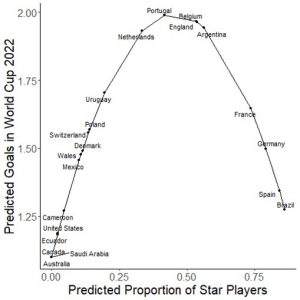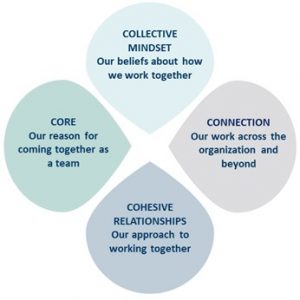By: Andy Loignon
A Beautiful Game…
As an American, I arrived late to the game of soccer.1 It was only after living in France – and seeing the cultural jubilation after as their 2018 men’s national team progressed through the World Cup tournament – that I came to appreciate the international relevance and beauty of this sport. Fun fact: When France clinched the title, I happened to be hosting family on a day trip to Paris. You can imagine the spirited fun on the subway that day. Today, I, along with 5 billion other people around the world, regularly watch soccer matches and pull for my favorite club (or team, for those not indoctrinated into soccer).2
The Too Much Talent Effect at World Cup 2022?
On the eve of this year’s World Cup, I find myself drawing connections between CCL’s work on team development and what often unfolds on the soccer field. Most notably, soccer teams exhibit what is known as the too much talent effect.3 This effect occurs when adding more and more talented team members provides less and less benefit to team performance. Such a counterintuitive effect is quite puzzling. Most of us would presume that recruiting, selecting, and retaining the most talented individuals results in the best team. After all, isn’t that what the war for talent allegedly taught us?4
The key takeaway from the “the too much talent effect” is that skills and abilities can contribute to a team’s outcome – but only up to a certain point. Consider Figure 1 below. Based on the level of talent each country will put on the field, this plot shows the predicted number of goals for each match at this year’s World Cup. These results come from analyses based on the proportion of star players that will likely comprise each country’s team in this year’s tournament.5 “Star player” is defined as a player whose performance exceeds 90% of all other soccer players in the world.6 For example, teams like Brazil and Spain have the most talented rosters (i.e., nearly 100% of their players are considered stars). Other teams, like the United States and Ecuador, have far fewer star players.
As Figure 1 shows there is a tipping point at which talent, all by itself, provides diminishing returns. That is, adding additional talented players doesn’t produce the expected increase in goals. Once the all-stars make up around 50% of the team, the effects of cumulative talent stall and even begin to decline.
Figure 1. The Too Much Talent Effect at World Cup 2022

This finding is fascinating. Many people will look at this figure and ask, “What is going on here? How can having a team of all-stars not be as beneficial as having a mediocre team?” Although a clear answer has yet to emerge, some studies suggest that too many star players leads to jostling for status and prestige – eventually resulting in blurred role assignments.7 This then creates the unfortunate situation of the stars becoming more of a liability than an asset, and ultimately limits the overall effectiveness of the team.
This finding is also comforting. For team leaders, this finding suggests that they have more flexibility in how they compose their team. Rather than simply pursuing the most talented individuals, they can consider how different levels of talent are combined and integrated within their team.
Finally, this finding is refreshing. If it were a simple 1:1 relationship between talent and team performance, imagine how boring the World Cup would be. The outcome of any tournament would be predetermined long in advance of the match. Plus, as an American, if I’m being completely honest, the U. S. team would have no chance!8
What the Too Much Talent Effect Means for Team Development
If we zoom out, the implications of the too much talent effect become even more compelling. First, the effect shows up everywhere from other sports (e.g., basketball) to traditional organizational settings (e.g., teams of stockbrokers, consultants or salespeople).9 For team members, this finding suggests that there is something about having a mix of all-stars and supporting cast that contributes to exceptional performance. Thus, those of us in supporting roles can, and likely do, play critical roles in achieving the team’s objectives. This means that team leaders, regardless of their context, can’t simply hire or select the most talented team members and expect to achieve top-flight results. Instead, other factors must be considered.
To better understand these factors, we recently developed CCL’s Framework on Team Effectiveness (see Figure below). This framework, which is based on CCL’s collective experience supporting leaders and their teams as well as a comprehensive review of the existing literature, presumes that four domains are critical for effective teams. Interestingly, having too little or too much talent, falls under a single domain (i.e., Core, or the reason the team has come together). This component emphasizes have the right purpose, practices, and people. It’s the last component, people, that reflect the amount of talent and ability that is composed within the team. The remaining domains (i.e., Collective Mindset, Cohesive Relationships, and Connection) highlight all the ways in which teams can be more or less effective independent of the talent within the group.
Figure 2. CCL’s Framework on Team Effectiveness

Returning to the soccer field, the U.S. Men’s National Team (USMNT) hopes to excel in domains beyond Core.10 For example, several commentators have discussed how the team will need to have a clear understanding of the system that their head coach, Gregg Berhalter, has implemented. Knowing each other’s role responsibilities, and how those might change from minute-to-minute and from match-to-match, are quintessential examples of a Collective Mindset. Equally important is discussion about the USMNT’s need to maintain their collective confidence and team spirit as they face more talented countries. The ability for team members to trust one another and cultivate supportive relationships fits squarely within Cohesive Relationships. Even the Connections formed by the USMNT’s players during their professional team assignments (e.g., competing in the United States vs. Europe) have been considered a bellwether for how well they might do in this year’s tournament.
As an American fan, I’m hoping these team effectiveness domains are operating in full force when the tournament gets underway. So, if you have a minute, you should join me and watch a few World Cup matches to see if the all-star teams reach their full potential or if the teams in the middle of the pack exceed their expectations.
References
1 At the risk of being overly U.S. centric, I’ve chosen to use the term soccer while acknowledging that the vast majority of fans refer to the sport as football.
2 https://publications.fifa.com/en/vision-report-2021/the-football-landscape/
3 Swaab, R. I., Schaerer, M., Ancich, E. M., Ronay, R., & Galinsky, A. D. (2014). The too-much-talent effect: team interdependence determines when more talent is too much or not enough. Psychological Science, 25(8), 1581-1591.
4 https://www.mckinsey.com/capabilities/people-and-organizational-performance/our-insights/gone-for-now-or-gone-for-good-how-to-play-the-new-talent-game-and-win-back-workers
5 The rosters for many national teams are still in flux. Thus, this is a historical analysis of the types of talent these countries have typically fielded over the years.
6 Swaab, R. I., Schaerer, M., Ancich, E. M., Ronay, R., & Galinsky, A. D. (2014). The too-much-talent effect: team interdependence determines when more talent is too much or not enough. Psychological Science, 25(8), 1581-1591.
7 Szatmari, B. (in press). Young stars and red giants: The moderating effect of age diversity on the relationship between the proportion of high performers and team performance. Journal of Applied Psychology. doi:https://doi.org/10.1037/apl0000971
8 Most analysis of the United States Men’s National Team going into this year’s tournament acknowledges that the roster is less talented than the other teams they will likely face (https://theathletic.com/3684916/2022/10/12/usmnt-tactics-gregg-berhalter/).
9 Groysberg, B., Polzer, J. T., & Elfenbein, H. A. (2011). Too many cooks spoil the broth: How high-status individuals decrease group effectiveness. Organization Science, 22(3), 722-737.
10 https://theathletic.com/3684916/2022/10/12/usmnt-tactics-gregg-berhalter/


